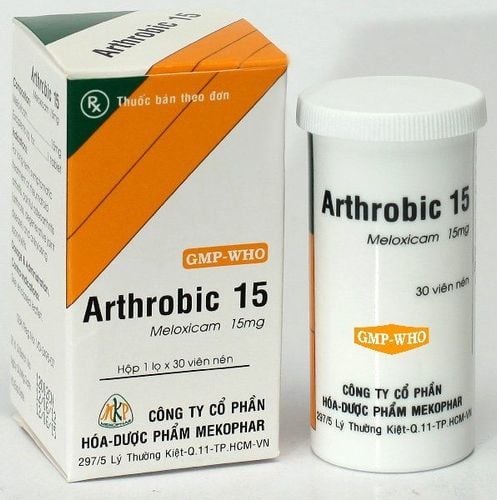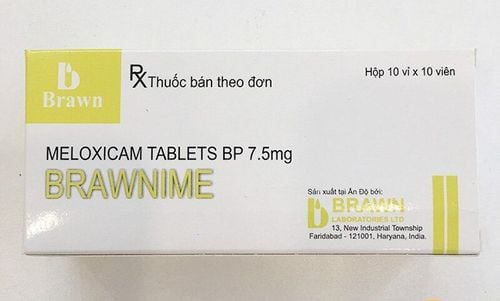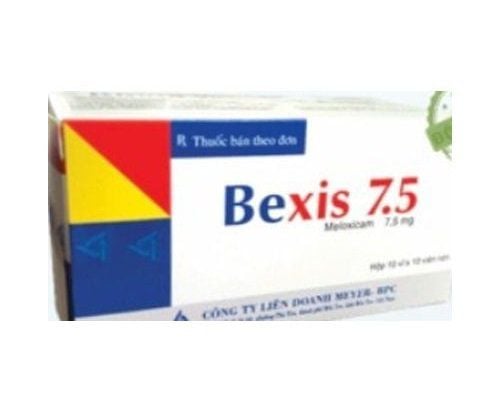This is an automatically translated article.
OTDxicam is indicated for long-term symptomatic treatment of chronic pain inflammation in osteoarthritis, rheumatoid arthritis, ankylosing spondylitis,... So what is OTDxicam? What should be noted when using? Let's learn the necessary information about the use of OTDxicam through the article below.
1. What is OTDxicam?
Manufacturer: company Branch of Armephaco Joint Stock Company
Drug group: Pain reliever, antipyretic, Non-Steroid anti-inflammatory, Gout treatment and osteoarthritis
Dosage form: Dispersible tablets
Packing: Box of 2 blisters x 10 tablets
Ingredients:
Meloxicam 7.5mg Other excipients just enough for 1 tablet
2. Uses of Otdxicam
Effects
OTDxicam is a non-steroidal anti-inflammatory drug (NSAID) of the Oxicam family, with anti-inflammatory, analgesic and antipyretic properties.
2.1 Indications Meloxicam is indicated for the long-term symptomatic treatment of chronic inflammatory pain in:
Osteoarthritis pain (joint damage, osteoarthritis). Rheumatoid arthritis. Ankylosing spondylitis . 2.2 How to use – Dosage How to use: Use orally. Should be taken after meals to avoid stomach irritation. The dosage form is a dispersible tablet, so it can be dispersed in about 15ml of water into a suspension and then taken orally, or can be taken as a regular tablet
Dosage:
Dosage for adults: Exacerbations of resorption osteochondrosis: 7.5 mg/day (one 7.5 mg tablet); if necessary, in the absence of improvement, the dose can be increased to 15 mg/day (two 7.5 mg tablets). Rheumatoid Arthritis, Ankle Spondylitis: 15 mg/day (two 7.5 mg tablets). According to the therapeutic response, the dose may be reduced to 7.5 mg/day (one 7.5 mg tablet). In order to minimize the incidence of adverse events, the lowest dose with the shortest response time should be used. The patient's medication needs and response to treatment should be reassessed periodically, especially in patients with osteoarthritis.
Take care not to exceed a maximum dose of 15 mg/day
Dose for elderly patients and patients at high risk of adverse reactions: Recommended dose for long-term treatment of rheumatoid arthritis and inflammatory arthritis Ankylosing spondylitis in elderly patients is 7.5 mg per day. Patients at risk of adverse reactions should initiate treatment with 7.5 mg daily.
Patients at high risk for adverse reactions include those with a history of esophagitis, gastritis and/or peptic ulcer.
Dosage for treatment of renal impairment: In patients with severe renal impairment, the dose should not exceed 7.5 mg per day. No dose reduction is required in patients with mild to moderate renal impairment (i.e., patients with creatinine clearance greater than 25 ml/min). 2.3 Overdose, missed dose and management Overdose: Symptoms following an acute NSAID overdose are usually lethargy, somnolence, nausea, vomiting, and epigastric pain, which are usually reversible with care. support. Gastrointestinal bleeding may occur. Severe poisoning can lead to hypertension, acute renal failure, liver dysfunction, respiratory failure, coma, convulsions, cardiovascular collapse and cardiac arrest. Anaphylactoid reactions have been reported with oral administration of NSAIDs and may occur after overdose.
Patients need care and support after an NSAID overdose. Rapid elimination of OTDxicam by 4 g of Cholestyramine taken three times a day has been demonstrated in a clinical trial.
Missed dose : avoid missed dose; If a dose is missed, the patient should skip the missed dose and do not overlap the dose with the next dose.
Do not skip doses more than 2 times in a row.
3. Notes/ Precautions when using OTDxicam
Contraindications
Do not use OTDxicam products for people with a history of hypersensitivity to any of the ingredients in the drug.
Contraindicated in cases of children and adolescents under 16 years of age, pregnant women in the last 3 months of pregnancy Contraindicated in the treatment of pain caused by surgery after coronary artery bypass surgery ( CABG). Do not use the product in patients with a history of gastrointestinal bleeding or perforation related to previous NSAID therapy, Crohn's disease, ulcerative colitis Do not treat patients with impaired liver function severe reduction, severe non-dialysis renal failure, severe heart failure Caution:
With caution in patients with gastrointestinal problems, taking anticoagulants Attention should be paid to patients taking use other drugs with NSAID ingredients to avoid additive side effects on the gastrointestinal tract and avoid overdose Do not use the drug during pregnancy and lactation During the period of drug use, the patient absolutely adheres to According to the dosage instructions of the treating doctor, avoid increasing or decreasing the dose to speed up the treatment time. Before stopping using the drug, the patient should consult the treating doctor. again. Medicines should be stored in a dry place, with moderate humidity and out of direct sunlight. Keep away from children's play areas, to prevent children from taking the medicine without knowing it.
4. Side effects of the drug OTDxicam
Common adverse reactions: headache, dyspepsia, nausea, vomiting, abdominal pain, constipation, flatulence, diarrhea, peptic ulcer, GI perforation or bleeding, sometimes fatal, especially In the elderly may occur Rare adverse reactions: Hypersensitivity, allergic reactions other than anaphylactoid or anaphylactoid reactions, increased blood pressure, flushing of the face, asthma in persons allergic to aspirin or other NSAIDs, angioedema, pruritus, rash, sodium and water retention, renal failure.
5. Drug interactions
OTDxicam should not be taken with other non-steroidal anti-inflammatory drugs (including salicylates) because taking multiple non-steroidal anti-inflammatory drugs at the same time may increase the risk of ulceration and gastrointestinal bleeding due to synergistic effects.
Anticoagulants, ticlopidine, heparin, thrombolytics when used with OTDxicam have an increased risk of bleeding. Anticoagulant effect should be monitored if used in combination
When taking non-steroidal anti-inflammatory drugs with lithium increases blood lithium
When OTDxicam is used with Methotrexate, it will increase the hematologic toxicity of Methotrexate Need to monitor Monitor the patient's blood count.
Diuretics used with OTDxicam may lead to acute renal failure in dehydrated patients. Patients taking OTDxicam with diuretics must be adequately rehydrated and renal function monitored before treatment
When taking OTDxicam with antihypertensive drugs (beta-blockers, ACE inhibitors, vasodilators, diuretics) May reduce the antihypertensive effect by inhibiting the synthesis of vasodilator prostaglandins.
OTDxicam may reduce the effectiveness of contraceptives placed in the uterus to prevent pregnancy completely, during the use of OTDxicam, it is necessary to combine additional methods of contraception such as using condoms.
Patients need to inform their doctors or pharmacists about the medicines or health foods they are taking at this time to avoid unwanted drug interactions.
Please dial HOTLINE for more information or register for an appointment HERE. Download MyVinmec app to make appointments faster and to manage your bookings easily.













